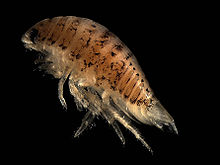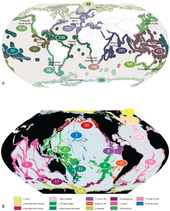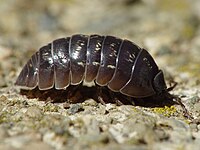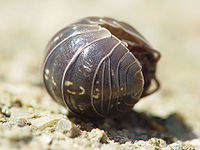Isopoda
| Isopoda Temporal range: LatestCarboniferoustopresent
| |
|---|---|

| |
| Eurydice pulchra,a carnivorous isopod found on sandy shores | |
| Scientific classification | |
| Domain: | Eukaryota |
| Kingdom: | Animalia |
| Phylum: | Arthropoda |
| Class: | Malacostraca |
| Superorder: | Peracarida |
| Order: | Isopoda Latreille,1817[1] |
| Suborders | |
Isopodais anorderofcrustaceans.Members of this group are calledIsopodsand include both terrestrial and aquatic species such aswoodlice.All have rigid, segmentedexoskeletons,two pairs ofantennae,seven pairs of jointed limbs on thethorax,and five pairs of branchingappendageson theabdomenthat are used inrespiration.Females brood their young in a pouch under their thorax.
Isopods have various feeding methods: some eat dead or decaying plant and animal matter, others aregrazers,orfilter feeders,a few arepredators,and some are internal or externalparasites,mostly of fish.Aquatic speciesmostly live on the seabed or bottom of freshwaterbodies of water,but sometaxacan swim for a short distance.Terrestrialforms move around by crawling and tend to be found in cool, moist places. Some species are able to roll themselves into a ball as a defense mechanism or to conserve moisture.
There are over 10,000 identified species of isopod worldwide, with around 4,500 species found in marine environments, mostly on the seabed, 500 species in fresh water, and another 5,000 species on land. The order is divided into elevensuborders.The fossil record of isopods dates back to theCarboniferousperiod (in thePennsylvanian epoch), at least 300 million years ago, when isopods lived in shallow seas. The name Isopoda is derived from theGreekrootsiso-(fromἴσοςísos,meaning "equal" ) and-pod(fromποδ-,thestemofπούςpoús,meaning "foot" ).[2][3]
Description
[edit]
showing the head with eyes and antennae, carapace and relatively uniform limbs
Classified within thearthropods,isopods have achitinousexoskeleton and jointed limbs.[4]Isopods are typically flatteneddorsoventrally(broader than they are deep),[5]although many species deviate from this rule, particularly parasitic forms, and those living in the deep sea or inground water habitats.Their colour may vary, from grey to white,[6]or in some cases red, green, or brown.[7]Isopods vary in size, ranging from someMicrocerberidaespecies of just.3 millimetres (0.012 in) to the deep seagiant isopodBathynomusspp.of nearly 50 cm (20 in).[3]Giant isopods lack an obviouscarapace(shell), which is reduced to a "cephalic shield" covering only the head. This means that thegill-like structures, which in other related groups are protected by the carapace, are instead found on specialised limbs on the abdomen.[3][8]Thedorsal(upper) surface of the animal is covered by a series of overlapping, articulated plates which give protection while also providing flexibility. The isopod body plan consists of a head (cephalon), a thorax (pereon) with seven segments (pereonites), and an abdomen (pleon) with six segments (pleonites), some of which may be fused.[5]The head is fused with the first segment of the thorax to form thecephalon.There are two pairs of unbranchedantennae,the first pair beingvestigialin land-dwelling species. The eyes arecompoundand unstalked and the mouthparts include a pair ofmaxillipedsand a pair ofmandibles(jaws) with palps (segmented appendages with sensory functions) and lacinia mobilis (spine-like movable appendages).[9]
The seven free segments of the thorax each bear a pair of unbranched pereopods (limbs). In most species these are used for locomotion and are of much the same size,morphologyand orientation, giving the order its name "Isopoda", from theGreekequal foot.In a few species, the front pair are modified intognathopodswith clawed, gripping terminal segments. The pereopods are not used in respiration, as are the equivalent limbs inamphipods,but the coxae (first segments) are fused to thetergites(dorsal plates) to form epimera (side plates). In mature females, some or all of the limbs have appendages known asoostegiteswhich fold underneath the thorax and form abrood chamberfor the eggs. In males, thegonopores(genital openings) are on the ventral surface of segment eight and in the females, they are in a similar position on segment six.[9]
One or more of the abdominal segments, starting with the sixth segment, is fused to thetelson(terminal section) to form a rigidpleotelson.[9][10][11]The first five abdominal segments each bear a pair ofbiramous(branching in two) pleopods (lamellarstructures which serve the function of gas exchange, and in aquatic species serve asgillsand propulsion),[3][12]and the last segment bears a pair of biramousuropods(posterior limbs). In males, the second pair of pleopods, and sometimes also the first, are modified for use in transferringsperm.The endopods (inner branches of the pleopods) are modified into structures with thin, permeable cuticles (flexible outer coverings) which act as gills forgas exchange.[9]In some terrestrial isopods, these resemblelungs.[3]
Diversity and classification
[edit]

Isopods belong to the larger groupPeracarida,which are united by the presence of a special chamber under the thorax for brooding eggs. They have acosmopolitan distributionand over 10,000speciesof isopod, classified into 11 suborders, have been described worldwide.[3][13]Around 4,500 species are found in marine environments, mostly on the sea floor. About 500 species are found infresh waterand another 5,000 species are the terrestrialwoodlice,which form the suborder Oniscidea.[14]In the deep sea, members of the suborderAsellotapredominate, to the near exclusion of all other isopods, having undergone a largeadaptive radiationin that environment.[14]The largest isopod is in the genusBathynomusand some large species are fished commercially for human food inMexico,JapanandHawaii.[15]
Some isopod groups have evolved aparasiticlifestyle, particularly as external parasites of fish.[9]They can damage or kill their hosts and can cause significant economic loss to commercial fisheries.[16]Inreef aquariums,parasitic isopods can become a pest, endangering the fish and possibly injuring the aquarium keeper. Some members of the familyCirolanidaesuck the blood of fish, and others, in the familyAegidae,consume the blood, fins, tail and flesh and can kill the fish in the process.[17]
The World Marine, Freshwater and Terrestrial Isopod Crustaceans database subdivides the order into eleven suborders:[1]
- Asellota– This suborder contains the superfamily Aselloidea, a group that contains most of the freshwater isopods in the northern hemisphere, and the superfamilies Stenetrioidea, Gnathostenetroidoidea and Janiroidea, which are mostly marine. The latter superfamily, Janiroidea, has a massive radiation of deepsea families, many of which have taken bizarre forms.
- Calabozoida– A small suborder consisting of two marine species in the familyCalabozoidaeand one freshwater species in the familyBrasileirinidaewhich is found in subterranean locations.[18]
- Cymothoida– Chiefly marine isopods[9]with over 2,700 species. Members are mostly carnivorous or parasitic. Includes the familyGnathiidae,the juveniles of which are parasitic on fishes.[19]The previously recognised suborderEpicarideais included as two superfamilies within this suborder and Cymothoida now includes part of the formerly recognised suborderFlabellifera.[20]Also includes the former suborder Anthuridea, a group of worm-like isopods with very long bodies.
- Limnoriidea– Mainly tropical isopods, some of which are herbivorous.[20]
- Microcerberidea– Tiny, worm-like isopods that live between particles on the bed of freshwater and shallow marine habitats.[9]
- Oniscidea– Semi-terrestrial and terrestrial isopods fully adapted for life on land.[9]There are over 4,000 species of woodlice inhabiting forests, mountains, deserts and thelittoral zone.[21]
- Phoratopidea– A single marine species,Phoratopus remex,which warrants its own suborder because of its unique characteristics.[20]
- Phreatoicidea– Small suborder of freshwater isopods resemblingamphipods,limited to South Africa, India, Australia and New Zealand.[9]
- Sphaeromatidea–Benthicisopods mostly from the southern hemisphere with respiratory pleopods inside a branchial chamber. This suborder now includes part of the formerly recognised suborder Flabellifera.[20][22]
- Tainisopidea– Freshwater isopods in a "relictual environment".[20]
- Valvifera– A large group of benthic, marine isopods with respiratory pleopods inside a branchial chamber under the abdomen.[9]
Evolutionary history
[edit]Isopods first appeared in thefossil recordduring theCarboniferousperiod of thePaleozoicsome 300 million years ago.[23]They were primitive, short-tailed members of the suborderPhreatoicidea.At that time, Phreatoicideans were marine organisms with a cosmopolitan distribution. Nowadays, the members of this formerly widespread suborder formrelic populationsin freshwater environments in South Africa, India and Oceania, the greatest number of species being inTasmania.Other primitive, short-tailed suborders includeAsellota,Microcerberidea,Calabozoideaand the terrestrialOniscidea.[14]
The short-tailed isopods have a short pleotelson and terminal, stylus-like uropods and have a sedentary lifestyle on or under the sediment on the seabed. The long-tailed isopods have a long pleotelson and broad lateral uropods which can be used in swimming. They are much more active and can launch themselves off the seabed and swim for short distances. The more advanced long-tailed isopods are mostlyendemicto the southern hemisphere and may have radiated on the ancient supercontinent ofGondwanasoon after it broke away fromLaurasia200 million years ago. The short-tailed forms may have been driven from the shallow seas in which they lived by increased predatory pressure from marine fish, their main predators. The development of the long-tailed forms may also have provided competition that helped force the short-tailed forms intorefugia.The latter are now restricted to environments such as the deep sea, freshwater, groundwater and dry land. Isopods in the suborder Asellota are by far the mostspecies-richgroup of deep sea isopods.[14]
Locomotion
[edit]Unlike the amphipods, marine and freshwater isopods are entirelybenthic.This gives them little chance to disperse to new regions and may explain why so many species areendemicto restricted ranges. Crawling is the primary means of locomotion, and some species bore into the seabed, the ground or timber structures. Some members of the familiesSphaeromatidae,IdoteidaeandMunnopsidaeare able to swim pretty well, and have their front three pairs of pleopods modified for this purpose, with their respiratory structures limited to the hind pleopods. Most terrestrial species are slow-moving and conceal themselves under objects or hide in crevices or under bark. The semi-terrestrialsea slaters(Ligiaspp.) can run rapidly on land and many terrestrial species can roll themselves into a ball when threatened, a feature that has evolved independently in different groups and also in the marinesphaeromatids.[9][24][25]
Feeding and nutrition
[edit]
Isopods have a simple gut which lacks a midgut section; instead there arecaecaconnected to the back of thestomachin which absorption takes place. Food is sucked into theesophagus,a process enhanced in the blood-sucking parasitic species, and passed byperistalsisinto the stomach, where the material is processed and filtered. The structure of the stomach varies, but in many species there is a dorsal groove into which indigestible material is channelled and a ventral part connected to the caeca where intracellular digestion and absorption take place. Indigestible material passes on through thehindgutand is eliminated through theanus,which is on the pleotelson.[9]
Isopods aredetritivores,browsers,carnivores(includingpredatorsandscavengers), parasites, andfilter feeders,and may occupy one or more of these feeding niches. Only aquatic and marine species are known to be parasites or filter feeders.[26][27]Some exhibitcoprophagiaand will also consume their own fecal pellets.[27]Terrestrial species are in general herbivorous, with woodlice feeding on moss, bark, algae, fungi and decaying material. In marine isopods that feed on wood,celluloseis digested by enzymes secreted in the caeca.Limnoria lignorum,for example, bores into wood and additionally feeds on themyceliaof fungi attacking the timber, thus increasing thenitrogenin its diet. Land-based wood-borers mostly housesymbioticbacteria in the hindgut which aid in digesting cellulose. There are numerous adaptations to this simple gut, but these are mostly correlated with diet rather than by taxonomic group.[9]
Parasitic species are mostly external parasites of fish or crustaceans and feed on blood. The larvae of theGnathiidaefamily and adultcymothoididshave piercing and sucking mouthparts and clawed limbs adapted for clinging onto theirhosts.In general, isopod parasites have diverse lifestyles and includeCancricepon elegans,found in the gill chambers ofcrabs;Athelges tenuicaudis,attached to the abdomen of hermit crabs;Crinoniscus equitansliving inside the barnacleBalanus perforatus;cyproniscids,living insideostracodsand free-living isopods;bopyrids,living in the gill chambers or on thecarapaceofshrimpsand crabs and causing a characteristic bulge which is even recognisable in some fossil crustaceans; andentoniscidaeliving inside some species of crab and shrimp.[9][28]Cymothoa exiguais a parasite of the spotted rose snapperLutjanus guttatusin theGulf of California;it causes the tongue of the fish to atrophy and takes its place in what is believed to be the first instance discovered of a parasite functionally replacing a host structure in animals.[29]
Reproduction and development
[edit]In most species, the sexes are separate and there is littlesexual dimorphism,but a few species arehermaphroditicand some parasitic forms show large differences between the sexes.[9]Some Cymothoidans areprotandrous hermaphrodites,starting life as males and later changing sex, and some Anthuroideans are the reverse, beingprotogynous hermaphroditesthat are born female. Some Gnathiidans males are sessile and live with a group of females.[26]Males have a pair of penises, which may be fused in some species. The sperm is transferred to the female by the modified second pleopod which receives it from the penis and which is then inserted into a femalegonopore.The sperm is stored in a special receptacle, a swelling on theoviductclose to the gonopore. Fertilisation only takes place when the eggs are shed soon after a moult, at which time a connection is established between the semen receptacle and the oviduct.[9]
The eggs, which may number up to several hundred, are brooded by the female in themarsupium,a chamber formed by flat plates known asoostegitesunder the thorax. This is filled with water even in terrestrial species.[9]The eggs hatch asmancae,a post-larval stage which resembles the adult except for the absence of the last pair of pereopods. The lack of a swimming phase in thelife cycleis alimiting factorin isopoddispersal,and may be responsible for the high levels ofendemismin the order.[14]As adults, isopods differ from other crustaceans in thatmoultingoccurs in two stages known as "biphasic moulting".[3]First they shed theexoskeletonfrom the posterior part of their body and later shed the anterior part. The giant Antarctic isopodGlyptonotus antarcticusis an exception, and moults in a single process.[30]
Terrestrial isopods
[edit]The majority of crustaceans are aquatic and the isopods are one of the few groups of which some members now live on land.[31][32]The only other crustaceans which include a small number of terrestrial species areamphipods(likesandhoppers) anddecapods(crabs, shrimp, etc.).[31]Terrestrial isopods play an important role in many tropical and temperate ecosystems by aiding in the decomposition of plant material through mechanical and chemical means, and by enhancing the activity of microbes.[33]Macro-detritivores, including terrestrial isopods, are absent from arctic and sub-arctic regions, but have the potential to expand their range with increased temperatures in high latitudes.[34]
The woodlice, suborderOniscidea,are the most successful group of terrestrial crustaceans[9]and show variousadaptationsfor life on land. They are subject to evaporation, especially from their ventral area, and as they do not have a waxy cuticle, they need to conserve water, often living in a humid environment and sheltering under stones, bark, debris orleaf litter.Desert species are usually nocturnal, spending the day in a burrow and emerging at night. Moisture is achieved through food sources or by drinking, and some species can form their paired uropodal appendages into a tube and funnel water from dewdrops onto their pleopods. In many taxa, the respiratory structures on the endopods are internal, with aspiracleand pseudotrachaea, which resemble lungs. In others, the endopod is folded inside the adjoining exopod (outer branch of the pleopod). Both these arrangements help to prevent evaporation from the respiratory surfaces.[9]
Many species can roll themselves into a ball, a behaviour used in defense that also conserves moisture. Members of the familiesLigiidaeandTylidae,commonly known as rock lice or sea slaters, are the least specialised of the woodlice for life on land. They inhabit the splash zone on rocky shores, jetties and pilings, may hide under debris washed up on the shore and can swim if immersed in water.[9]
-
Armadillidium vulgareon the move...
-
...and rolled into a ball!
See also
[edit]References
[edit]- ^ab"Isopoda".WoRMS.World Register of Marine Species.2014.Retrieved8 May2014.
- ^"Isopod".Merriam-Webster.Encyclopædia Britannica.Retrieved27 June2014.
- ^abcdefgSchotte, M.; Boyko, C. B.; Bruce, N. L.; Markham, J.; Poore, G. C. B.; Taiti, S.; Wilson, G. D. F."World List of Marine, Freshwater and Terrestrial Isopod Crustaceans".World Register of Marine Species.Retrieved4 June2014.
- ^Valentine, J. W.(2004).On the Origin of Phyla.University of Chicago Press.p. 33.ISBN978-0-226-84548-7.
- ^abNaylor, E. (1978).British Marine Isopods: Keys and Notes for the Identification of the Species(2nd ed.). Academic Press. p.2.ISBN978-0-12-515150-4.
- ^"Isopod, Pillbug, Sow Bug Information".University of Arizona. 1997. Archived fromthe originalon 23 September 2014.Retrieved21 August2014.
- ^Lee, Welton L. (1966). "Color change and the ecology of the marine isopodIdothea (Pentidotea) montereyensisMaloney, 1933 ".Ecology.47(6): 930–941.Bibcode:1966Ecol...47..930L.doi:10.2307/1935640.JSTOR1935640.
- ^Keable, S. J.; Poore, G. C. B.; Wilson, G. D. F. (2 October 2002)."Australian Isopoda: Families".Australian Museum.Archived fromthe originalon 10 October 2018.Retrieved5 June2014.
- ^abcdefghijklmnopqrstRuppert, Edward E.; Barnes, Richard S.; Fox, Robert D. (2004).Invertebrate Zoology(7th ed.). Delhi: Cengage Learning. pp. 661–667.ISBN978-81-315-0104-7.OCLC970002268.
- ^Wilson, G. D. F. (1989)."A systematic revision of the deep-sea subfamily Lipomerinae of the isopod crustacean family Munnopsidae".Bulletin of the Scripps Institution of Oceanography.27:1–138.
- ^Wilson, G. D. F. (2009)."The road to the Janiroidea: Comparative morphology and evolution of the asellote isopod crustaceans".Journal of Zoological Systematics and Evolutionary Research.25(4): 257–280.doi:10.1111/j.1439-0469.1987.tb00608.x.
- ^Wilson, George D. F. (1991). "Functional morphology and evolution of isopod genitalia". In Bauer, Raymond T.; Martin, Joel W. (eds.).Crustacean Sexual Biology.Columbia University Press. pp. 228–245.ISBN978-0-231-06880-2.
- ^Martin, Joel W.; Davis, George E. (2001).An Updated Classification of the Recent Crustacea(PDF).Natural History Museum of Los Angeles County.p. 132. Archived fromthe original(PDF)on 12 May 2013.Retrieved14 December2009.
- ^abcdeBrusca, Richard (6 August 1997)."Isopoda".Tree of Life Web Project.Retrieved5 June2014.
- ^Williams, Ernest H. Jr. (2000).Keynote Address: Isopods as parasites or associates of fishes.Parasitology 2000: One Eye on the Future, One Eye on the Past. Southeastern Society of Parasitologists. pp. 9–10.
- ^Ravichandran, S.; Rameshkumar, G.; Balasubramanian, T. (2010)."Infestation of isopod parasites in commercial marine fishes".Journal of Parasitic Diseases.34(2): 97–98.doi:10.1007/s12639-010-0014-3.PMC3081733.PMID21966129.
- ^Shimek, Ronald L. (2002)."Pills, parasites, and predators; isopods in the reef aquarium".Reefkeeping.Vol. 1, no. 4.
- ^"Calabozoidea".WoRMS.World Register of Marine Species.2014.Retrieved5 June2014.
- ^Srour, Marc (13 July 2012)."Tongue Biters and Deep Sea Giants: The Cymothoida (Crustacea: Isopoda)".Teaching Biology.Archived fromthe originalon 6 June 2014.Retrieved8 May2014.
- ^abcdeBrandt, Angelika; Poore, Gary C. B. (2003). "Higher classification of the flabelliferan and related Isopoda based on a reappraisal of relationships".Invertebrate Systematics.17(6): 893–923.doi:10.1071/IS02032.
- ^Brusca, Richard; Coelho, Vania R.; Taiti, Stefano (2001)."Suborder Oniscidea (Terrestrial Isopods)".Tree of Life Web Project.Retrieved8 May2014.
- ^"Flabellifera".WoRMS.World Register of Marine Species.2014.Retrieved12 June2014.
- ^Schram, Frederick R. (1970). "Isopod from the Pennsylvanian of Illinois".Science.169(3948): 854–855.Bibcode:1970Sci...169..854S.doi:10.1126/science.169.3948.854.PMID5432581.S2CID31851291.
- ^Proceedings of the United States National Museum
- ^Malyutina, Marina V.; Frutos, Inmaculada; Brandt, Angelika (February 2018)."Diversity and distribution of the deep-sea Atlantic Acanthocope (Crustacea, Isopoda, Munnopsidae), with description of two new species".Deep Sea Research Part II: Topical Studies in Oceanography.148:130–150.Bibcode:2018DSRII.148..130M.doi:10.1016/j.dsr2.2017.11.003.
- ^abPoore, G. C.; Bruce, N. L. (2012)."Global diversity of marine isopods (except Asellota and crustacean symbionts)".PLOS ONE.7(8): e43529.Bibcode:2012PLoSO...743529P.doi:10.1371/journal.pone.0043529.PMC3432053.PMID22952700.
- ^abWarburg, M. R. (1987). "Isopods and their terrestrial environment".Advances in Ecological Research.17:187–242.doi:10.1016/S0065-2504(08)60246-9.ISBN9780120139170.ISSN0065-2504.
- ^Shields, Jeffrey."Epicaridea: The parasitic isopods of Crustacea".Virginia Institute of Marine Science. Archived fromthe originalon 5 January 2019.Retrieved23 March2014.
- ^Brusca, R. C.; Gilligan, M. R. (1983). "Tongue replacement in a marine fish (Lutjanus guttatus) by a parasitic isopod (Crustacea: Isopoda) ".Copeia.1983(3): 813–816.doi:10.2307/1444352.JSTOR1444352.
- ^George, Robert Y. (1972). "Biphasic moulting in Isopod Crustacea and the finding of an unusual mode of moulting in the antarctic genusGlyptonotus".Journal of Natural History.6(6): 651–656.Bibcode:1972JNatH...6..651G.doi:10.1080/00222937200770591.
- ^abBroly, Pierre; Deville, Pascal; Maillet, Sébastien (2012). "The origin of terrestrial isopods (Crustacea: Isopoda: Oniscidea)".Evolutionary Ecology.27(3): 461–476.doi:10.1007/s10682-012-9625-8.S2CID17595540.
- ^"Benthic animals".Icelandic Ministry of Fisheries and Agriculture.Archived fromthe originalon 11 May 2014.Retrieved4 June2014.
- ^Zimmer, M. (2002)."Nutrition in terrestrial isopods (Isopoda: Oniscidea): an evolutionary-ecological approach".Biological Reviews of the Cambridge Philosophical Society.77(4): 455–493.doi:10.1017/S1464793102005912.PMID12475050.S2CID42144479.
- ^Geffen, Koert G.; Berg, Matty P.; Aerts, Rien (2011)."Potential macro-detritivore range expansion into the subarctic stimulates litter decomposition: a new positive feedback mechanism to climate change?".Oecologia.167(4): 1163–1175.Bibcode:2011Oecol.167.1163V.doi:10.1007/s00442-011-2051-8.PMC3213348.PMID21735203.


